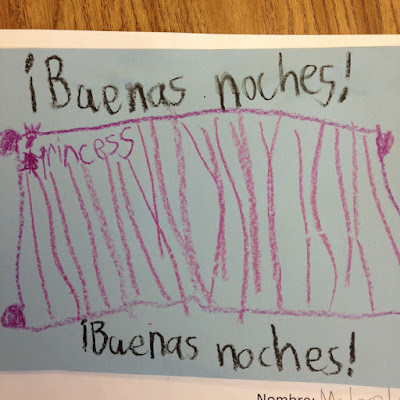First we watched these two videos.
In the younger grades, we compared and contrasted Papa Noel with Los Reyes Magos and sorted different items like los zapatos, las calcetines navideños, Roldofo el reno, los camellos, etc.
With the older students, I used this awesome infographic made by El Mundo de Pepita and students had to agree or disagree with the following statement, "Christmas celebrations in Spain are similar to celebrations here in the United States." Using evidence from the infographic, they had to support their position. We did do this part in English but only because I find reflecting on culture difficult to do in the TL at the novice level. With the rest of the unit's instruction in Spanish, this made up of my 10%.
Once students had an idea of who Los Reyes Magos and Papa Noel were we moved on to some coding. First we practiced together in a group, learning the direction words arriba, abajo, derecha, and izquierda. Then we applied them on the Hour of Code site with Mapas Felices and Laberintos with Angry Birds. (I did skip a few levels but my students didn't seem to suffer, mostly because they have done Hour of Code before with our STEM teacher.)
Next, we combined the two concepts - coding and Los Reyes Magos - by coding on paper. They had to get Los Reyes to Bélen and Papá Noel to the house by writing the code. Then we did it "live." Students moved the shoes around on a giant grid I had taped on my floor and then they wrote the code to get one of the kings to the shoe and deliver the gift. Once they were done they read their code aloud while one of their classmates listened and followed their directions - wearing a crown and holding a present of course!
 |
| Tres Reyes esperando por el mandato "Des el regalo." |
 |
| A 5th grader listening to the code his classmates wrote. |
The computer lab teacher was also doing Hour of Code right before break so I offered extra special purple bubbles (on our Si Se Puede bubble sheets purple indicates they've been using their Spanish outside of class) to anyone who changed the language to Spanish in computer lab.
When we get back from break we will review the celebrations related to Día de Reyes and if they've been very good everyone will get a small candy cane taped to the shoe they've colored on Friday, January 6th. We'll also do a fun and quick assessment using Plickers.
Overall, this unit will take about eight 25 minute class periods but could be adapted for longer classes and for most age levels. Although most of my kindergartners didn't quite grasp the coding concepts (they were the only ones who didn't code alone on the computer for this reason) it was still a good introduction for them.
If you're interested in the coding on paper worksheets you can get them in my Teachers Pay Teachers store.
So that's Hour of Code in Spanish class! I think I might do this every year. I can even change the Christmas tradition we study - I could see doing this with Las Posadas or Nochevieja traditions. Do you teach Hour of Code in your class? How do you teach Christmas traditions in Spain and Latin America? Share in the comments below or on Twitter with the hashtag #earlylang!















































